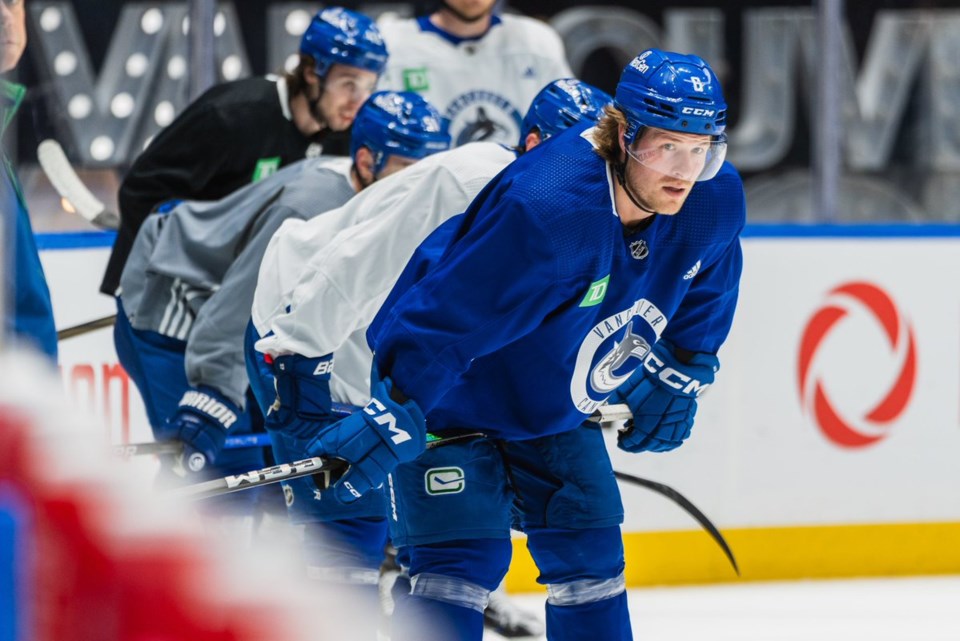When the Vancouver Canucks desperately needed a goal against the big bad Boston Bruins, Brock Boeser bucked up and put the puck top shelf, then completed the comeback in overtime with the game-winning goal.
The two-goal performance kept Boeser firmly ensconced in the top ten in NHL goalscoring with 33 goals, four goals ahead of his Canucks’ teammates, J.T. Miller and Elias Pettersson, with 29.
Boeser’s goalscoring renaissance has been one of the biggest stories of the Canucks’ surprising season, as he’s adapted his game to become one of the NHL’s sneakiest off-the-puck scorers, constantly finding his way into dangerous areas of the ice.
But even when Boeser isn’t scoring goals, he’s playing a major role in the Canucks’ offence. That’s not just referring to his underrated passing skills, even though Boeser is third among Canucks forwards in assists. No, I’m referring to how Boeser contributes even to goals where he doesn’t get a point at all.
Boeser was in on all three goals against the Bruins
Boeser’s best attribute when he entered the NHL was his wristshot; now his best attribute is his willingness to get to the front of the net. If Boeser doesn’t pick up an assist on a goal scored when he’s on the ice, that’s where he is almost always found, battling with the defenceman in front to take away the eyes of the goaltender.
That was the case on Saturday against the Bruins. It wasn’t just that Boeser scored two goals. On the game-tying goal that sent the game to overtime, Boeser was the man in front, cutting across the face of goaltender Jeremy Swayman at just the right time to take the goaltender’s eyes off of Filip Hronek’s shot.
That puck doesn’t go in without Boeser’s screen. There would be no game-tying goal, no cathartic overtime win, no jubilant Rogers Arena Crowd — just lamentations and gnashing of teeth over the Canucks’ fifth straight loss.
Net presence is one of the central tenets of Rick Tocchets’ coaching philosophy, though he’s certainly not the only coach who prizes it so highly. But it’s a constant refrain from Tocchet when the team is struggling: they’re playing too much on the perimeter, not getting to the net, and not getting enough traffic in front.
The simple truth is that modern NHL goaltenders are going to stop almost every shot they can see. They don’t even need to see the puck the whole way — if a goaltender can read the puck coming off the stick, he’s going to make the save almost every single time.
Boeser has become a master of taking away the goaltender’s eyes at just the right time to mask the release point of the shot and give his teammates a better chance to score, even if he doesn’t pick up an assist in the process.
Boeser's netfront presence in recent games
We just have to look at the last half-dozen games to find a bunch of examples. There was the screen on the Hronek goal against Boston, then several more examples from the Canucks’ loss to the Minnesota Wild, where Boeser had just two points, but contributed to three other goals with screens.
On Ian Cole’s goal, Boeser became immovable — he’s the second-heaviest forward on the team behind J.T. Miller — in a battle with Jon Merrill and forced goaltender Filip Gustavsson to look around him on the near post, leaving the far post wide open.
Then, on the power play, Boeser recognized Miller’s rotation into the high slot and even threw in a bit of coaching, motioning Elias Lindholm into the bumper before planting himself in the right spot to screen Gustavsson.
Finally, late in the game as the Canucks pushed for the comeback after giving up the lead, Boeser was once again planted in front of the net in a battle with Jake Middleton as Nikita Zadorov scored.
A game earlier, Boeser didn’t pick up a point against the Winnipeg Jets, but still provided the screen on Tyler Myers’ goal.
On that goal, Boeser first went to the backdoor for a potential pass. As he saw Myers driving across the slot, Boeser stepped in front of Connor Hellebuyck just as Myers shot, simultaneously giving him the near post and taking away Hellebuyck’s eyes.
A game before that, Boeser was once again in front of the net for a Miller goal.
Off a terrible Jeff Petry turnover, Boeser went straight to the front of the net and stopped in exactly the right place to take away Alex Lyon’s view of the puck as Miller shot it. As good as Miller’s shot is, Lyon might have been able to make the save if Boeser had kept skating past the front of the net or tried to stop up for a backdoor pass.
“I saw Brock getting to the net, so I was basically just waiting for him to get planted,” said Miller about that goal. “When I released it, I think he was staring into Brock’s number, so it’s one of those things where the timing was good and Brock did a great job.”
That’s six examples of Boeser screening the goaltender on a Canucks goal in just the last six games. It’s something he’s been doing all season and is a big reason why the Canucks have scored at such a prodigious rate when he’s on the ice. Boeser is doing a lot of the little things that lead to goals but don’t show up on his individual boxscore.




